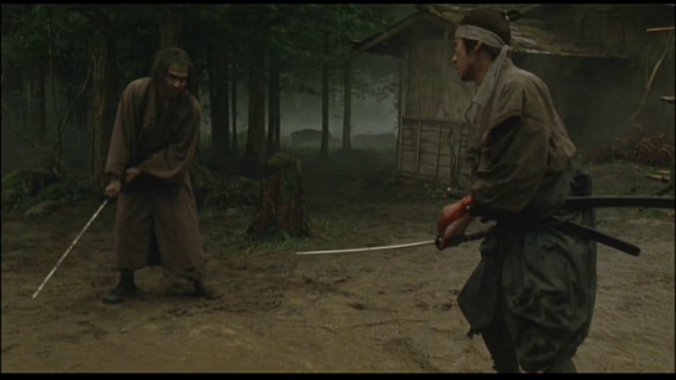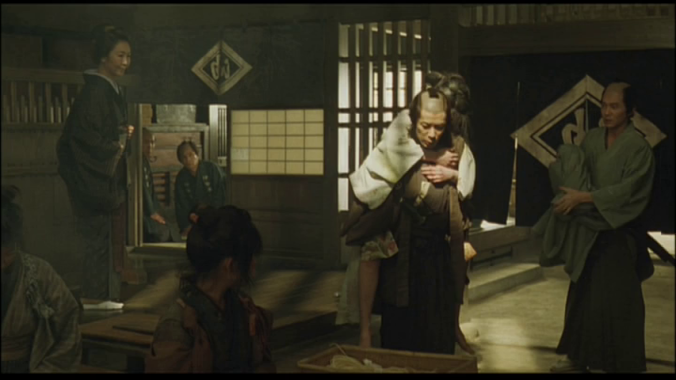 Hidden Blade revisits the end of the samurai era when western concepts are beginning to penetrate into the more remote areas of the country. Based on stories by Shuhei Fujisawa, whose work was also used for Twilight Samurai, and once again directed by Yoji Yamada, the story also concerns an impoverished samurai who is ordered by his clan to kill a lone rebel, but the movie is at once more complex and more simple in its combination of a samurai at war with his society and a love story.
Hidden Blade revisits the end of the samurai era when western concepts are beginning to penetrate into the more remote areas of the country. Based on stories by Shuhei Fujisawa, whose work was also used for Twilight Samurai, and once again directed by Yoji Yamada, the story also concerns an impoverished samurai who is ordered by his clan to kill a lone rebel, but the movie is at once more complex and more simple in its combination of a samurai at war with his society and a love story.
Set in the fictional clan territory of Unasaka, the story follows Katagiri as he and his friend Shimada bid farewell to Hazama, leaving for Edo. From the beginning, the rigidities of samurai caste and sexual attitudes are demonstrated as Hazama jokes about all the pretty women he will sleep with in Edo while his wife stands quietly to the side within hearing distance, then bids a careful farewell with a formal bow to his fellow samurai, barely nodding to his wife. Katagiri is a poor samurai, his salary reduced when his father committed suicide over irregularities in the clan finances for which he was not responsible, but the much richer Shimada will marry his sister anyway. The household is actually held together by the maid Kie, who must eventually be married off to a merchant. When Katagiri learns that Kie is being worked to death by her mother-in-law, he kidnaps her, forces her husband to divorce her, and brings her home. But neither he nor she can envision the possibility of marriage, despite their obvious love for each other, and rather than face further scandal, she is shipped back to her parents’ farm as soon as she is well enough.
But neither he nor she can envision the possibility of marriage, despite their obvious love for each other, and rather than face further scandal, she is shipped back to her parents’ farm as soon as she is well enough.
Meanwhile, the foreigners have arrived down south and a young man in a frock coat arrives to teach the samurai how to use western weaponry and to officer an army in the western way. This allows Yamada to depict the rigidity of samurai thinking with much more humor than in his previous movie, much of it visual, such as a cannon’s unexpected recoil, their inability to march in step (or to see any reason to do so), unwillingness to understand the need for, much less execute, instant response to commands without bowing, and even their inability to run efficiently.
All of this humor ends when Hazama is returned from Edo to be imprisoned for his part in a plot of some kind. He escapes and holes up in a peasant cottage with hostages, where Katagiri is ordered to kill him, since Katagiri had defeated Hazama in an earlier duel. Katagiri, however, knows that Hazama is by far the better swordsman and seeks advice from their old teacher, now retired to a farm, The sensei shows him a special move which we assume is the “Hidden Blade,” a throwback to the many different “styles” of sword fighting we saw in earlier films, such as Kyoshiro Nemuri’s Full Moon Cut. Unlike the Twilight Samurai, Katagiri does not offer Hazama a chance to escape, despite a plea from his wife who even offers sex to pay for it; instead, he tries to convince him to commit hara-kiri for an honorable death. Hazama insists on a duel and Katagiri’s special move does not work, so Hazama is killed by the riflemen waiting in the woods.
Most samurai films would end there, but Yamada has more to tell us. The real Hidden Blade will be used silently to rectify the corruption of the clan leader and Katagiri will resign his samurai life to become a tradesman or farmer in Hokkaido, stopping along the way to ask Kie if she will join him now that there are no caste differences between them.
As with Twilight Samurai, Yamada is more interested in the people than the fighting, though the duel itself is very well staged, moving outside where there is greater freedom of movement but still in the morning haze so beloved of traditional chanbara films. Masatoshi Nagase is sensitive and thoughtful as Katagiri, but the women add an extra depth. Takako Matsu is radiant as Kie, so that her illness is more disturbing than the usual sickness in films, and sharp eyes will spot Yamada’s good luck charm Chieko Baisho in a brief scene as Katagiri’s mother, but especially moving is Tomoko Kabata as Hazama’s wife. Obviously unloved by her husband, she nevertheless is all too submerged in the duties and attitudes of the samurai wife, pleading for the life of a man who does not love her and still doing the “right thing” when she too is betrayed by the clan councilor.
The changing world is clear in the contrast of the modernized soldiery with the samurai sword tradition, and as with Twilight Samurai Yamada provides us with a visual symbol of that change, as Hazama’s sword hand is shot off. Though Yamada provides no specific date, it is part of a historical moment that has been a constant fascination for Japanese writers and movie-makers, so for fans of Japanese movies it contains nothing specifically new. Yet the commitment, humor, and sensitivity of the performances and of Yamada’s unassuming direction make it seem fresh and fascinating throughout. It is elegaic in the way of so many American westerns of the late sixties and seventies, a view of an honorable past that is coming to an end yet fully aware that that honorable past was more myth than reality. As in most of Yamada’s movies, the past and the future are both built on average people trying to find their way through a changing world, this time in a society that for hundreds of years had not changed at all.




Pingback: Sword of Desperation / Hisshiken torisashi (2010) | Japanonfilm
Pingback: Love and Honor (2006) | Japanonfilm